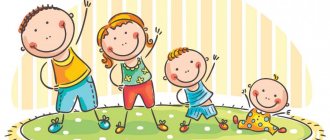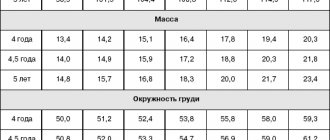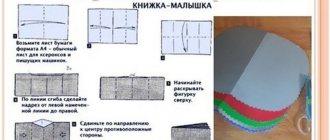Report “Physical education in preschool educational institutions and its significance”
Physical education in preschool educational institutions and its significance
Recently, health-saving technologies have been increasingly used in kindergartens. One of the directions of these technologies is the use in preschool institutions of methods to activate muscle tone and motor-coordinating systems. Physical education, as a form of active recreation during sedentary activities, is widely used with preschool children.
Physical education is physical exercise aimed at restoring children’s performance, improving their well-being, increasing attention, preventing fatigue, posture disorders, i.e. to improve the health of children's bodies. Complexes are exercises composed of different movements aimed at actively working various muscle groups and relaxing them; activation of attention, increased excitability of the nervous system, formation and strengthening of posture, as well as breathing. In addition to physical exercises, the complexes may include elements of massage, finger and breathing exercises, and eye exercises.
The purpose of a physical education session (dynamic pause) is to increase or maintain mental performance during direct educational activities, prevent fatigue, and provide short-term active rest for children when the organs of vision and hearing experience significant stress; muscles of the trunk, especially the back, which are in a static state; muscles of the working hand.
Physical education allows educators and teachers, as well as parents, to play with children, make them happy and, at the same time, develop speech, coordination and fine motor skills. In the process of performing physical exercises, blood circulation improves, areas of the cerebral cortex that were not involved in previous activity are excited, and those that did are inhibited. In this regard, fatigue of the muscles and nervous system is relieved, and children experience positive emotions and improve their mood.
Raising children to be physically perfect means ensuring that they are healthy and hardened from an early age.
To solve problems and improve the health of preschool children, various means of physical education are used, including physical education sessions. The integrated use of all means (hygienic factors, natural forces, physical exercise and others) effectively affects the child’s body.
Physical education is a small set of physical exercises performed for 2-3 minutes during classes in kindergarten, as well as at home when doing homework. It is built from 4-5 exercises for the arms, torso, and legs that do not require complex coordination.
Physical education minutes during a lesson in elementary school help children relieve stress from the educational process, slightly warm up from sitting at a desk for a long time, change the type of activity and then better assimilate new material. Physical education is a small set of physical exercises: bending, stretching, turning, jumping. All actions are performed to a poetic text. It is important that the poem for physical education is selected according to the age of the child.
It is important for the teacher to remember that the exercises and accompanying poem need to be changed periodically.
*** The wind is blowing in our faces, the children are waving their hands at their faces. The tree is swaying. - we raise our hands up and sway. The wind is quieter, quieter, quieter. - we squat Tree higher and higher. - We stand up, stretch our hands up.
*** Pinocchio stretched, - raise your arms up and stand on your toes. One - bent over, - bends forward, reaching your fingers to the floor. Two - bent over; Three - bent over. I spread my arms to the sides, I spread my arms to the sides. Apparently I couldn’t find the key. - we shake our heads. To get the key for us, - we raise our hands up. We need to stand on our tiptoes. - stretch up, standing on your toes.
***
We are funny monkeys, - the children get up from their seats. We play too loudly. We all stomp our feet, - we stomp our feet (walking) We all clap our hands, - we clap our hands, we puff out our cheeks, - the children puff out their cheeks, we jump on our tiptoes. - jumping Let's jump together to the ceiling - high jump Let's raise our finger to our temple - bring both index fingers to our temple And we'll even show each other our tongues! - they show their tongues; we'll open our mouths wider; - we'll open our mouths; we'll make grimaces. - they make grimaces. When I say word three, take away all the grimaces. One, two, three! - take their seats
*** So we spread our hands, As if we were surprised. And they bowed to each other to the ground! Bent over, straightened up, Bent over, straightened up. Lower, lower, don’t be lazy, bow and smile.
*** One - rise, stretch, Two - bend down, straighten up, Three - clap your hands, three claps, Three nods with your head. At four - arms wider, at five - to wave your arms, at six - to sit quietly in your place.
*** Children repeat the exercises after the teacher, and at the same time repeat the concepts of right and left.
We will put our palms to our eyes, we will spread our strong legs. Turning to the right, Let's look around majestically. And you also need to look to the left from under your palms. And - to the right! And also Over the left shoulder!
*** We put on the record and go out to warm up. We start running on the spot, the finish line is in two hundred meters! One-two, one-two, Enough, they came running, Stretched, breathed.
*** Everyone raised their hands - once! The whole class stands on their toes, Two sit down, hands down, Turn towards the neighbor. Once! - And up, Two! - And down, And turn to your neighbor. Let's get up together to give our legs something to do. One - sat down, Two - stood up. Those who tried to squat can already rest.
*** One, two – we will bend over slightly. Three, four - hands on hips, we will do multi-jumps. Five, six - you need to climb onto the ladder. Seven, eight – we’ll ask you to go for a run. Nine, ten - that's all. We'll meet again soon.
*** Good morning, kids! — the children rise from their desks and stand in the aisle. It’s time for everyone to wake up! They stretched - they stretched. — stretching on their toes. They’re almost awake. Hands to the sides, forward - we spread our hands to the sides and bring them forward. And now it’s the other way around. Bent over to the toes - bend towards the toes We ran on the toes. - We run quietly in place. Jump and jump together. - jumping in place We continue our lesson. — the children sit at their desks.
*** In the morning, the children went into the forest - the children walk, raising their legs high. And in the forest they found mushrooms - they do squats, they bent over, collected - bending forward, along the way they got lost - raising their arms to the sides.
*** My back is straight - the children stand up and straighten their shoulders. I’m not afraid of bending - bending forward. I straighten up, bend over, turn around. - we make turns. One two three four. Three - four, one - two. I walk with a proud posture. - turn to the sides, keep my head straight, - bow forward I’m not in a hurry. - hands behind your back and walking in place One - two, three - four, - turns the body Three - four, one - two. - again walking in place. I can bow. - bow And sit down and bend over, - squat and bow forward Turn back and forth! — turns Oh, straight back! One - two, three - four, - body turns Three - four, one - two. - walking in place again.
Thematic physical exercises in elementary school lessons
Thematic physical education lessons in elementary school lessons
Primary school teacher Liliya Ivanovna Dudina
The purpose of physical exercises is to actively change the children’s activities, ease the onset of fatigue, and then switch the child back to continuing classes. Main tasks: 1) relieve fatigue and tension; 2) add an emotional charge; 3) improve gross motor skills; 4) develop clear coordinated actions in relation to speech; 5) training speed skills and performing mental operations. In my work with children, I use health-saving technologies, among which I especially highlight thematic physical exercises. I believe that this material will be useful to any teacher going to a lesson in primary school.
1. Physical exercises in the lessons of the surrounding world
“Where are there a lot of vitamins?” Children stand in a circle. I throw the ball to any student, naming the product. If this product contains a lot of vitamins, then the student catches the ball, and the rest clap their hands. If there are no vitamins in the product, they throw it away and everyone stamps their feet. “Herbs, shrubs, trees” I name various plants. With a full squat, children show grass, stand at full height - bushes, hands up - trees. “We’ll play Traffic Light” One, two, three, four, five! Oh, we're tired of writing. (Stretching.) We will play “Traffic Light”, (Walking in place.) Stretch our arms and legs. (Shaking arms. Shaking legs.) Red light for us “Stop!” - shouts, orders to wait for green. So that the wait won't be boring, we bend down together. And back. And forward. (Tilts.) Left, right turn. (Turns the torso.) Now the yellow light is on, it’s time to get ready. Let's warm up our arms and legs, (Jerks with arms in front of the chest.) Let's start, kids! (Walking in place.) We’ll lift it up, we’ll lower it down, we’ll fly like an airplane. (Jumping.) When the green light turns on, we can go forward. Left, right, Left, right, (Running with a high hip lift.) We boldly move forward. (Walking in place.) The traffic light is a glorious assistant. It doesn’t let us get tired. In a lesson on the topic “How a plant develops,” you can play the game “How a plant grew”: I invite the children to imagine that they are small seeds falling into the soil (children squat down, squeezing into a ball). Next I tell you how a plant develops from a seed. — The little seed in the soil was cold in winter, it squeezed to keep warm (muscle tension, eyes closed). In spring, the sun's rays warmed the earth and the seed warmed up and straightened its shoulders (muscle relaxation). He became so interested in what was up there that it slowly began to grow. It has roots (children rise to their feet, open their eyes) and first leaves (raise their arms above their heads, bent at the elbows). The sun warmed the sprout that emerged from the seed so much that it decided to become tall and tall in order to wave its leaves to the sun (children stretch up, rise on tiptoe, wave their hands). And then one day a flower bloomed on a sprout, it smiled at the sun and other flowers (children smile at the teacher and each other, turning from side to side). And then autumn came and in place of the flower, seeds formed, which the plant dropped into the soil (hand movements, as if shaking off water, are aimed at relieving accumulated muscle tension). This is how the plant grew for a whole year.

2. Physical exercises in mathematics lessons
During math lessons in the first grade I play the game “The sea is agitated...”, then I show a fish with an example and name the answer. If it is correct, then the children clap, if not, then they stomp. The text is read before the exercises begin. – We count to five, we squeeze the weights, (i.p. - standing, legs slightly apart, raise your arms slowly up to the sides, fingers clenched into a fist (4-5 times)) – How many times will I hit the tambourine, How many times will we chop the wood , (i.p. - standing, feet shoulder-width apart, hands clasped upward, sharp bends forward - down) - How many green Christmas trees, how many bends we will perform, (i.p. - standing, legs apart, hands on the belt. Bends are performed ) - We squat as many times as we have butterflies (i.p. - standing, legs slightly apart. During squats, arms forward) - Stand on tiptoes, reach the ceiling (i.p. - main stance, hands on the belt. Rising to socks, arms up - to the sides, stretch) - How many lines to the point, How many times will we stand on our toes (4-5 times), (i.p. - the main stance. When lifting on your toes, arms to the sides - up, palms below shoulder level ) - We will count, collect mushrooms (i.p. - standing, feet shoulder-width apart. Bend forward (imitation of mushroom picking) - How many circles will I show, How many jumps will you perform (5 x 3 times), (i.e. p. - standing, hands on the belt, jumping on the toes) - We count the berries, squat together, (p. - basic stance, hands on the belt. Don’t lower your head, straight back) We clap our hands seven times, eight times with our feet let's stomp. Add three to seven - That's how much we have to sit down. (7 claps, stomp each foot 4 times, 10 squats.) Draw a triangle with your eyes. Now turn it upside down. And again, use your eyes to guide the perimeter. Draw a figure eight vertically. Don’t turn your head, but only carefully follow the lines of the water with your eyes. And put it on the side. Now follow horizontally, and stop in the center. Close your eyes tightly, don't be lazy. We finally open our eyes. Charging has ended. Well done! (Children imagine the appearance of geometric shapes.)
3. Physical exercises in writing and Russian language lessons
In the first grade, in order for children to quickly remember capital letters, I use the “Guess the Letter” minute: one child stands with his back to everyone and writes a capital letter in the air with a magic wand, and the rest guess.
The presenter changes with the one who guessed right. I throw minutes with a ball, call the word children - divide it into syllables, name synonyms, antonyms, put emphasis. “Soft separating sign” If you hear a soft separating sign in a word, you will sit down, if there is none, you will jump. “Soft sign” Do you run, hurry, eat, do you remember the soft sign? “Nouns” If you hear masculine nouns, you need to clap, if you hear feminine ones, you need to jump, if you hear the middle gender, you need to spread your arms. “Adjective name” Try to show the signs of objects with movements, facial expressions, gestures: big, hot, narrow, cheerful, tall, small, etc. “Phraseological menagerie” What names of animals can be added to the following phrases? Children name animals and use pantomime or facial expressions to depict them. Hungry like... (a wolf). Cunning like ... (fox). Cowardly as... (hare). Inflated like... (turkey). Clumsy like... (a bear). Stubborn as ... (donkey). Healthy as... (bull). Prickly, like... (hedgehog). If a vowel letter raises doubts, do not slowly put it under stress. I YOU, HE, SHE are a friendly family together. Together we learn to read, together we learn to write. And of course, and of course - to distinguish a sound from a letter. One, two, one, two - you can’t write a sound for us. We pronounce the sound, hear it, and write the letters in the notebook. Consist of letters of the word. He knows it, you, me. One, two, three, four, five - We all need to know clearly. We read, write, pronounce and hear sounds. Distinguish a sound from a letter And get an A. One, two, three, four, five - We all need to know this. The combination of ZHI and SHI We write only with the letter I. Thicket, grove - here CHA- SHCHA Is friends only with the letter A. I drag and drag the pike, And with happiness I shout to everyone - CHU and SHCHU, CHU and SHCHU Write everything with the letter U. ( When pronouncing the words of physical exercises, children repeat the movements after the teacher) Remember once and for all, That the vowels E, E, Y, I, At the beginning of the word, as always, indicate two sounds. There are four letters in the word TREE, but if you count the sounds, then, of course, there are not four of them. And in the FIR-tree there will be five sounds. And if in a word after the vowel there are E, Yo, Yu, Ya. Then in each such letter there will be not one sound, but two. You need to write it together. “Parts of a word” The text is written on the board. Before performing physical exercises, you need to restore the text by inserting the necessary prefixes. Dear children need to _become, Hands slowly _to. Fingers _press, then _press, So stand for a second. Release your hand smoothly. Repeat again With at – with the prefix, sit down, With with – with the prefix, rise, With under – jump, wink, With with – with the prefix, laugh. We stretch out our arms. S o - let's lower them again. That's all. The time has come to complete the exercise. Effective implementation of preventive and health-improving technologies with students at school is possible only with the purposeful, systematic activities of the teacher. And in the end I would like to remember the words of K.D. Ushinsky: “Give the child a little movement, and he will reward you again with ten minutes of live attention, and ten minutes of live attention, when you were able to use them, will give you more than a whole week of half-asleep activities.” »
We recommend watching:
A set of relaxation minutes for elementary school. Space physical education minutes for children 5-6 years old. Physical exercises for younger schoolchildren. Animated physical exercises for the eyes in the PoverPoint program step by step with photos.
Similar articles:
Gymnastics for the eyes. Exercises for children
Sets of exercises for physical education minutes and physical education breaks
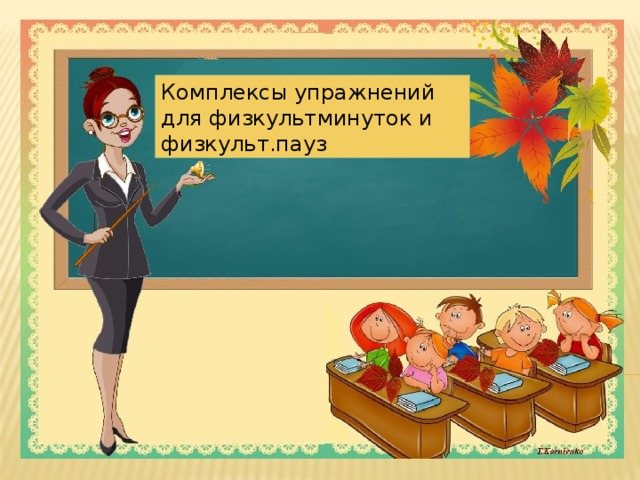
Sets of exercises for physical education minutes and physical education breaks
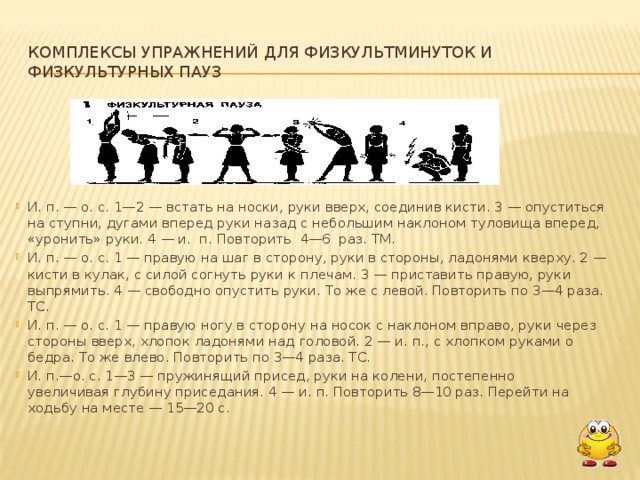
Sets of exercises for physical education minutes and physical education breaks
- I. p. - o. With. 1-2 - stand on your toes, arms up, bringing your hands together. 3 - lower yourself onto your feet, arch your arms forward and back with your torso slightly tilted forward, “drop” your arms. 4 - i. n. Repeat 4-6 times. TM.
- I. p. - o. With. 1 - right one step to the side, arms to the sides, palms up. 2 - hands into a fist, forcefully bend your arms to your shoulders. 3 - place your right hand, straighten your arms. 4 - lower your arms freely. Same with the left. Repeat 3-4 times. TS.
- I. p. - o. With. 1 - right leg to the side on the toe with a tilt to the right, arms across the sides up, clap the palms above the head. 2 - i. p., with hands clapping on hips. Same to the left. Repeat 3-4 times. TS.
- I.p.-o. With. 1-3 - spring squat, hands on knees, gradually increasing the depth of the squat. 4 - i. n. Repeat 8-10 times. Go to walking in place - 15-20 s.
Sets of exercises for physical education minutes and physical education breaks
- I. p. - o. With. 1—raising your shoulders up, arms to the sides. 2 - “drop” your hands, bend slightly. 3 - arms up in arcs to the sides, stand on your toes, stretch. 4 - i. n. Repeat 4-6 times. TM.
- I. p. - o. With. 1 - right one step to the side, hands to shoulders. 2-3 - two circular movements with arms bent back. 4 - i. p., relax your hands. Same with the left. Repeat 2-3 times back and forth. TS.
- I. p. - o. With. 1 - swing your left leg to the side, arms to the sides. 2 - lunge to the left with a tilt to the right. 3-4 - springy tilt to the right - and. n. Same with the right. Repeat 3-4 times. TS.
I. p. - o. With. Running in place—15-20 sec. Go to walking in place -15-20 sec.
I. p. - o. With. 1 - right one step to the side, hands to shoulders. 2 - bend forward, bending over, arms to the sides. 3 - straighten up and turn right. 4 - i. n. Same with the left. Repeat 3-4 times. TS.
I. p. - o. s, hands on the belt. 1 - bend your right leg forward. 2 - straightening the leg forward, swing back. 3 - repeat the same as on the count “1”. 4 - i. n. Same with the left. Repeat 3-4 times. TS.
I. p. - o. With. 1 - left hand back on the toe, right hand to the side, left hand up. 2 - put your left foot down, your right hand up, your left hand forward. 3 - change the position of your hands. 4 - i. p., relax your arms, shake your hands. Repeat 3-4 times. Gradually speed up the pace to fast.
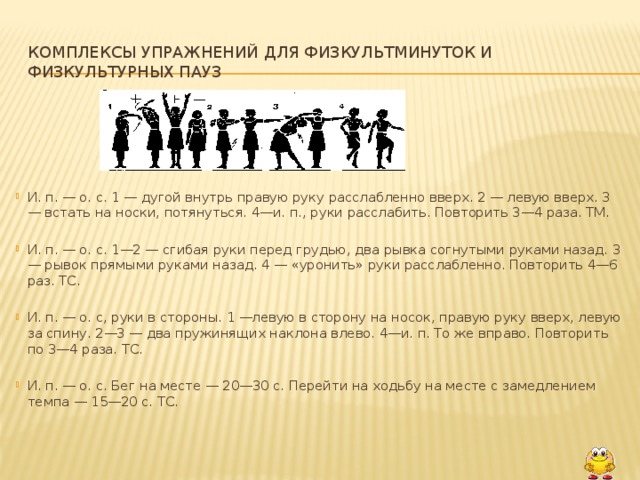
Sets of exercises for physical education minutes and physical education breaks
- I. p. - o. With. 1 - with an arc inward, the right arm is relaxed upward. 2 - left up. 3 - stand on your toes and stretch. 4—i. p., relax your hands. Repeat 3-4 times. TM.
- I. p. - o. With. 1-2 - bending your arms in front of your chest, two jerks with your bent arms back. 3 - jerk back with straight arms. 4 - “drop” your hands in a relaxed manner. Repeat 4-6 times. TS.
- I. p. - o. s, arms to the sides. 1 - left to the side on the toe, right hand up, left behind the back. 2-3 - two springy tilts to the left. 4—i. n. Same to the right. Repeat 3-4 times. TS.
- I. p. - o. With. Running in place - 20-30 s. Switch to walking in place at a slower pace - 15-20 sec. TS.
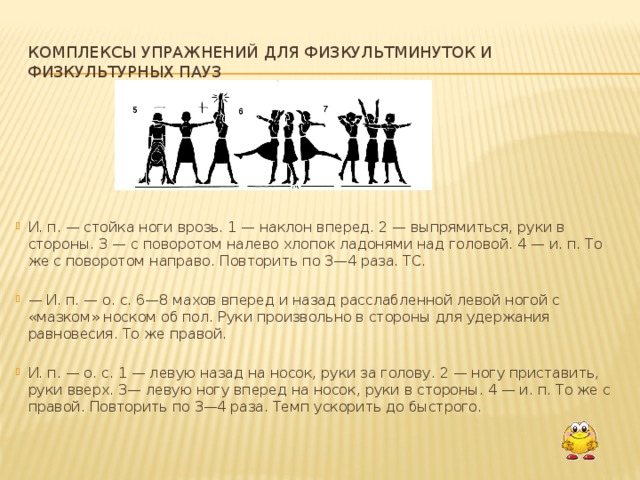
Sets of exercises for physical education minutes and physical education breaks
- I. p. - stand with legs apart. 1—lean forward. 2 - straighten up, arms to the sides. 3 - with a turn to the left, clap your palms above your head. 4 - i. n. The same with a right turn. Repeat 3-4 times. TS.
- - I. p. - o. With. 6-8 swings forward and back with a relaxed left leg with a “smear” of the toe on the floor. Hands randomly to the sides to maintain balance. Same with the right one.
- I. p. - o. With. 1 - left back on the toe, hands behind the head. 2 - put your foot down, arms up. 3—left foot forward on the toe, arms to the sides. 4 - i. n. Same with the right. Repeat 3-4 times. Speed up the pace to fast.

Sets of exercises for physical education minutes and physical education breaks
- 1 I. p. -o. With. 1-2 - right back on the toe, arms up and to the sides, head back. 3 - place your right hand, hands to your shoulders. 4 - i. n. Same with the left. Repeat 2-3 times. TM.
- I. p. - o. With. 1 - hands behind your head. 2 - stand on your toes, bend over, pull your elbows back. 3 - lower yourself onto your feet, bring your elbows together. 4 - arms relaxed down with a slight tilt forward. Repeat 4-6 times. TS.
- I. p. - o. s, hands on the belt. 1 - right leg to the side on the heel, left hand behind the head, turn the head to the right. 2-3 - two springy tilts to the right. 4 - i. n. The same to the left. Repeat 3-4 times. TS.
- I. p. - o. With. 1—squat, arms to the sides. 2-3 - spring squat, hands behind the head. 4 - i. p. Repeat 8 times. Go to walking in place - 15-20 s.
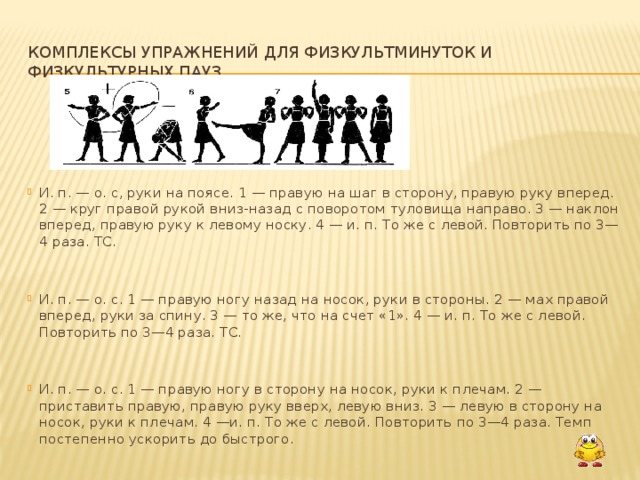
Sets of exercises for physical education minutes and physical education breaks
- I. p. - o. s, hands on the belt. 1 - right one step to the side, right hand forward. 2 - circle with the right hand down and back with the body turning to the right. 3 - lean forward, right hand to left toe. 4 - i. n. Same with the left. Repeat 3-4 times. TS.
- I. p. - o. With. 1 - right leg back on the toe, arms to the sides. 2 - swing the right hand forward, hands behind the back. 3 - the same as counting “1”. 4 - i. n. Same with the left. Repeat 3-4 times. TS.
- I. p. - o. With. 1 - right leg to the side on the toe, hands to the shoulders. 2 - place your right hand, right hand up, left hand down. 3 - left to the side on the toe, hands to the shoulders. 4 -i. n. Same with the left. Repeat 3-4 times. Gradually speed up the pace to fast.
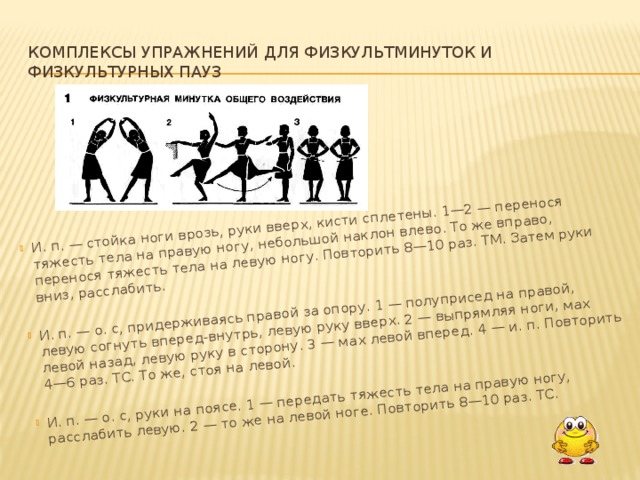
- I. p. - stand with legs apart, arms up, hands intertwined. 1-2 - transferring the weight of the body to the right leg, slightly tilting to the left. Do the same to the right, transferring the weight of the body to the left leg. Repeat 8-10 times. TM. Then hands down, relax.
- I. p. - o. s, holding the right support. 1 - half squat on the right, bend the left forward and inward, left arm up. 2 - straightening your legs, swing your left back, left arm to the side. 3 - left swing forward. 4 - i. n. Repeat 4-6 times. TS. The same thing, standing on the left.
- I. p. - o. s, hands on the belt. 1 - transfer the weight of the body to the right leg, relax the left. 2 - the same on the left leg. Repeat 8-10 times. TS.
Sets of exercises for physical education minutes and physical education breaks
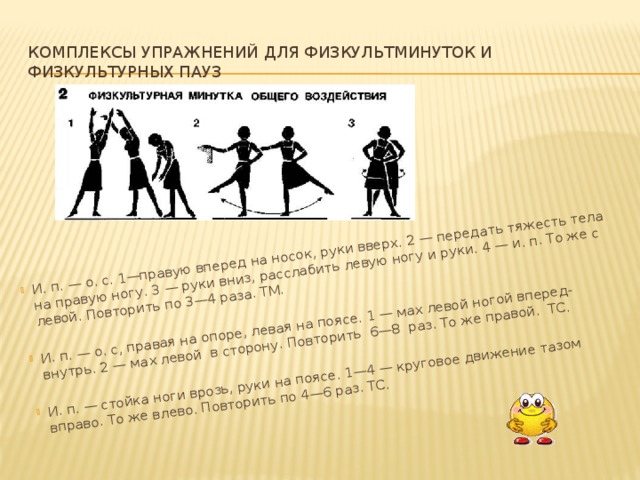
- I. p. - o. With. 1—right forward on the toe, arms up. 2 - transfer the weight of the body to the right leg. 3 - arms down, relax your left leg and arms. 4 - i. n. Same with the left. Repeat 3-4 times. TM.
- I. p. - o. s, right on the support, left on the belt. 1 - swing the left leg forward and inward. 2 - left swing to the side. Repeat 6-8 times. Same with the right one. TS.
- I. p. - stand with legs apart, hands on the belt. 1-4 - circular movement of the pelvis to the right. Same to the left. Repeat 4-6 times. TS.
Sets of exercises for physical education minutes and physical education breaks
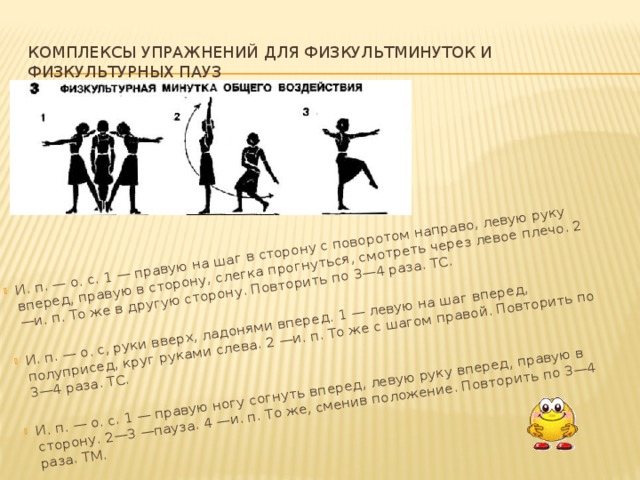
- I. p. - o. With. 1 - right hand one step to the side with a turn to the right, left hand forward, right hand to the side, bend slightly, look over your left shoulder. 2 -i. n. The same in the other direction. Repeat 3-4 times. TS.
- I. p. - o. s, arms up, palms forward. 1 - left one step forward, half squat, circle with arms to the left. 2 -i. p. The same with a right step. Repeat 3-4 times. TS.
- I. p. - o. With. 1 - bend your right leg forward, left arm forward, right arm to the side. 2-3 - pause. 4 -i. n. The same, changing position. Repeat 3-4 times. TM.
Sets of exercises for physical education minutes and physical education breaks

- I. p. - o. With. 1—left step forward, half squat, arms to the sides with a slight tilt to the right. 2 - pushing off with the left, and. etc., cross your arms loosely in front of your chest. The same in the other direction. Repeat 3-4 times. TS.
- I. p. - o. With. 1 - right back, right hand up, left hand forward. 2 - i. p., hands behind your back. 3 - bending down. 4—i. n. Same with the left. Repeat 3-4 times. TS.
- I. p. - o. With. 1 - lunge forward with the left, arms forward and downwards. 2 - stand on your left toe, bend your right back, arms to the left. 3 - the same as counting “1”. 4 - i. n. Perform together. The same with the right. Repeat 3-4 times. TS.
Sets of exercises for physical education minutes and physical education breaks

- I. p. - o. With. 1—right leg, tapping to the side on the toe with a tilt to the right, right hand on the belt, left hand behind the head, turn the head to the right. 2-3 - springy tilt to the right with heel tapping on the floor. 4 - i. n. The same to the left. Repeat 3-4 times. TS.
- I. p. - o. s, hands up. 1 - half squat with a turn to the left, arms to the sides. 2 - straighten up, arms up with clap above your head. The same in the other direction. Repeat 3-4 times. TS.
- I. p. - o. s, hands on the belt. 1 - left foot forward on the toe, left hand forward. 2 - left leg to the side, left arm to the side. 3 - left leg back on the toe, hand on the belt. 4 - i. n. Perform together. The same in the other direction. Repeat 4-6 times. TS.
Sets of exercises for physical education minutes and physical education breaks
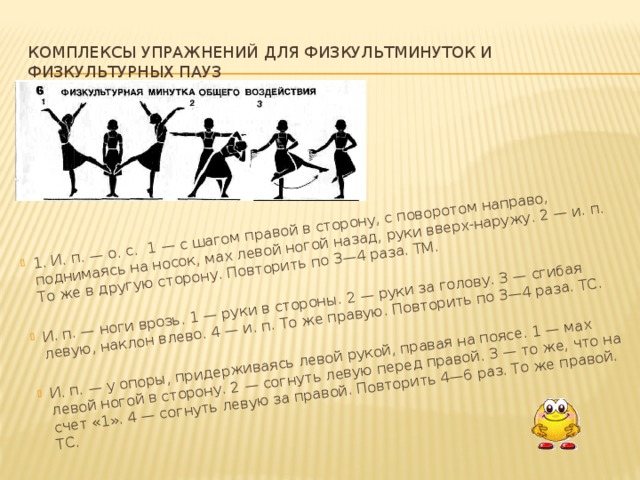
- 1. I. p. - o. With. 1 - with a right step to the side, with a turn to the right, rising on your toes, swinging your left leg back, arms up and out. 2 - i. n. The same in the other direction. Repeat 3-4 times. TM.
- I. p. - legs apart. 1 - arms to the sides. 2 - hands behind your head. 3 - bending the left, tilt to the left. 4 - i. p. Same right. Repeat 3-4 times. TS.
- I. p. - at the support, holding with the left hand, the right one on the belt. 1 - swing your left leg to the side. 2 - bend the left one in front of the right one. 3 - the same as counting “1”. 4 - bend the left behind the right. Repeat 4-6 times. Same with the right one. TS.
Sets of exercises for physical education minutes and physical education breaks

Sets of exercises for physical education minutes and physical education breaks
- I. p. - sitting, arms relaxed, 1-4 - four circular movements with shoulders forward. Same thing back. Repeat 2-3 times. Lower your arms and relax your shoulders. TM.
- I. p. - sitting, arms relaxed. 1 - arms to the sides, hands clenched into fists. 2 - unclench your hands, spread your fingers. 3 - hands up, shake hands.
- 4 - “drop” your arms, relax your shoulders. Repeat 4-6 times. TS.
- 3. Self-massage of the shoulder joints and shoulder girdles. I. p. - sitting, left hand relaxed on the thigh. With your right hand, perform: (from the spine) stroking in a straight line and in a circle; rubbing in a circle; kneading with fingertips; stroking. 50-60 s. The same thing, changing the position of the hands. Then shake your relaxed hands.
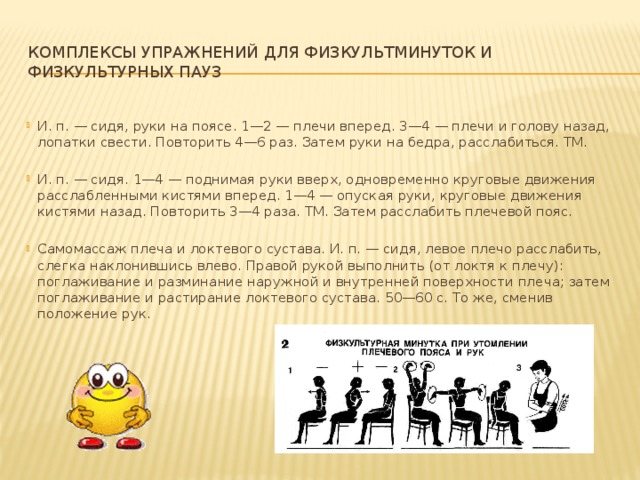
Sets of exercises for physical education minutes and physical education breaks
- I. p. - sitting, hands on the belt. 1-2 - shoulders forward. 3-4 - shoulders and head back, shoulder blades together. Repeat 4-6 times. Then hands on your hips, relax. TM.
- I. p. - sitting. 1-4 - raising your arms up, at the same time making circular movements with your relaxed hands forward. 1-4 - lowering your arms, making circular movements with your hands back. Repeat 3-4 times. TM. Then relax your shoulder girdle.
- Self-massage of the shoulder and elbow joint. I. p. - sitting, relax your left shoulder, leaning slightly to the left. With your right hand, perform (from elbow to shoulder): stroking and kneading the outer and inner surfaces of the shoulder; then stroking and rubbing the elbow joint. 50-60 s. The same thing, changing the position of the hands.
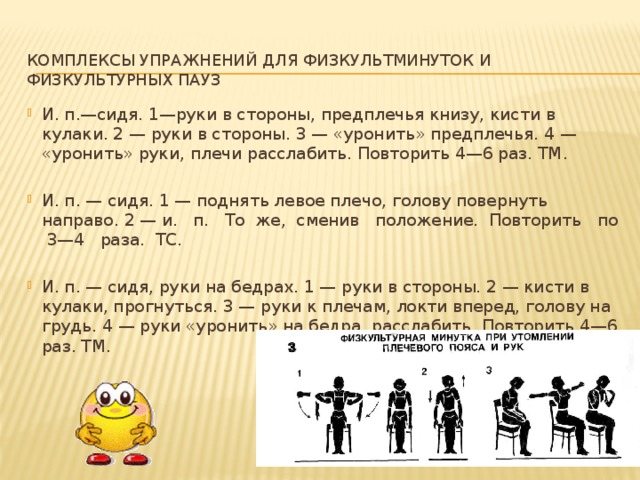
Sets of exercises for physical education minutes and physical education breaks
- I. p.—sitting. 1—arms to the sides, forearms down, hands in fists. 2 - arms to the sides. 3 - “drop” your forearms. 4 - “drop” your arms, relax your shoulders. Repeat 4-6 times. TM.
- I. p. - sitting. 1 - raise your left shoulder, turn your head to the right. 2 - i. n. The same, changing position. Repeat 3-4 times. TS.
- I. p. - sitting, hands on hips. 1 - arms to the sides. 2 - hands into fists, bend over. 3 - hands to shoulders, elbows forward, head on chest. 4 - “drop” your hands on your hips, relax. Repeat 4-6 times. TM.
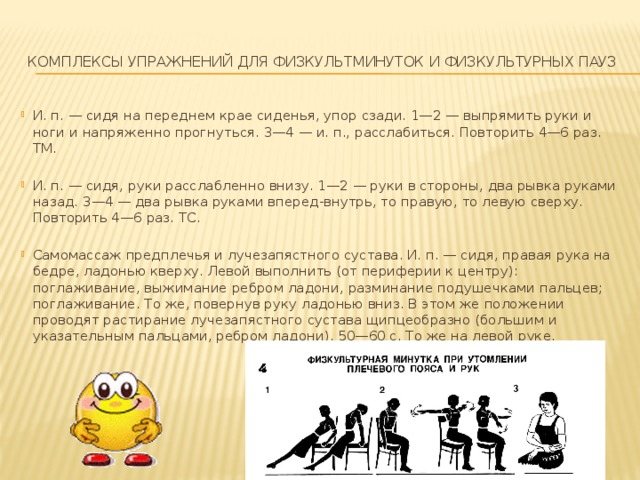
Sets of exercises for physical education minutes and physical education breaks
- I. p. - sitting on the front edge of the seat, support at the back. 1-2 - straighten your arms and legs and bend over tensely. 3-4 - and. p.s., relax. Repeat 4-6 times. TM.
- I. p. - sitting, arms relaxed below. 1-2 - arms to the sides, two jerks with arms back. 3-4 - two jerks with your hands forward and inward, then right, then left from above. Repeat 4-6 times. TS.
- Self-massage of the forearm and wrist joint. I. p. - sitting, right hand on hip, palm up. Left perform (from the periphery to the center): stroking, squeezing with the edge of the palm, kneading with the fingertips; stroking. The same, turning your hand palm down. In the same position, the wrist joint is rubbed in a forceps manner (with the thumb and forefinger, the edge of the palm). 50-60 s. The same on the left hand.
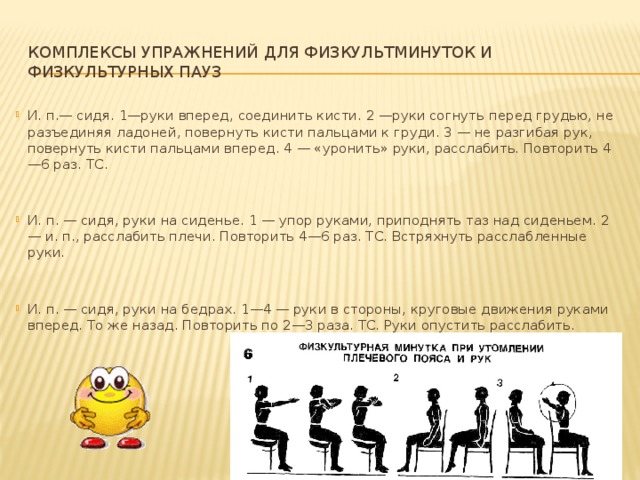
Sets of exercises for physical education minutes and physical education breaks
- I. p. - sitting. 1—arms forward, connect hands. 2 - bend your arms in front of your chest, without separating your palms, turn your hands with your fingers towards your chest. 3 - without straightening your arms, turn your hands forward with your fingers. 4 - “drop” your hands, relax. Repeat 4-6 times. TS.
- I. p. - sitting, hands on the seat. 1 - support with your hands, raise your pelvis above the seat. 2 - i. etc., relax your shoulders. Repeat 4-6 times. TS. Shake your relaxed hands.
- I. p. - sitting, hands on hips. 1-4 - arms to the sides, circular movements of the arms forward. Same thing back. Repeat 2-3 times. TS. Lower your arms and relax.
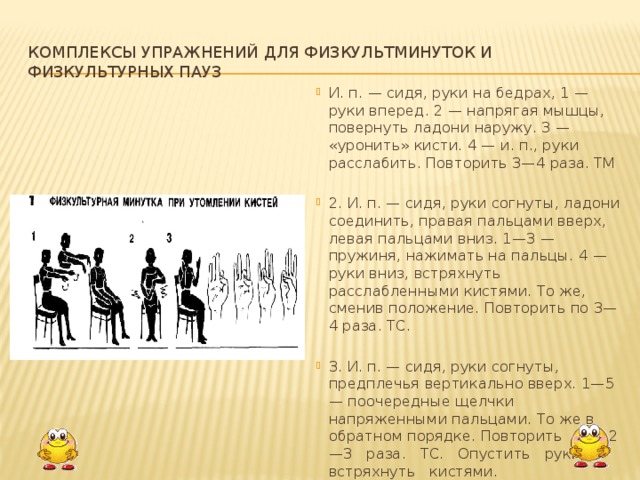
Sets of exercises for physical education minutes and physical education breaks
- I. p. - sitting, hands on hips, 1 - hands forward. 2 - straining your muscles, turn your palms outward. 3 - “drop” the brushes. 4 - i. p., relax your hands. Repeat 3-4 times. TM
- 2. I. p. - sitting, arms bent, palms together, right fingers up, left fingers down. 1-3 - spring, press on your fingers. 4 - hands down, shake with relaxed hands. The same thing, changing position. Repeat 3-4 times. TS.
- 3. I. p. - sitting, arms bent, forearms vertically upward. 1-5 - alternate clicks with tense fingers. The same in reverse order. Repeat 2-3 times. TS. Lower your arms, shake your hands.
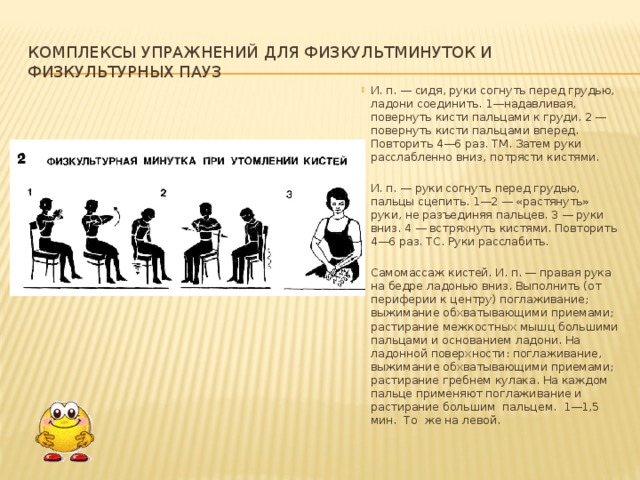
Sets of exercises for physical education minutes and physical education breaks
- I. p. - sitting, bend your arms in front of your chest, put your palms together. 1—pressing, turn the hands with your fingers towards the chest. 2 - turn your hands forward with your fingers. Repeat 4-6 times. TM. Then relax your arms down and shake your hands.
- I. p. - bend your arms in front of your chest, clasp your fingers. 1-2 - “stretch” your arms without separating your fingers. 3 - hands down. 4 - shake with brushes. Repeat 4-6 times. TS. Relax your hands.
- Self-massage of hands. I. p. - right hand on the thigh, palm down. Perform (from the periphery to the center) stroking; squeezing with grasping techniques; rubbing the interosseous muscles with the thumbs and heel of the palm. On the palmar surface: stroking, squeezing with grasping techniques; rubbing with the comb of a fist. Stroking and rubbing with the thumb are used on each finger. 1-1.5 min. The same on the left.
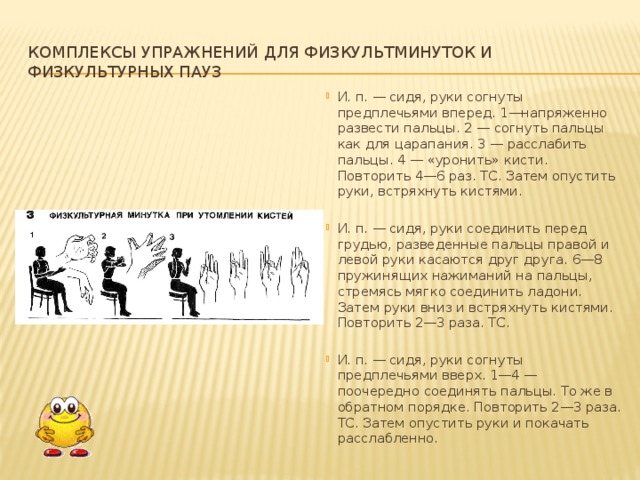
Sets of exercises for physical education minutes and physical education breaks
- I. p. - sitting, arms bent with forearms forward. 1—spread your fingers tensely. 2 - bend your fingers as if for scratching. 3 - relax your fingers. 4 - “drop” the brushes. Repeat 4-6 times. TS. Then lower your arms and shake your hands.
- I. p. - sitting, join hands in front of the chest, spread fingers of the right and left hands touch each other. 6-8 springy pressures on the fingers, trying to gently connect the palms. Then arms down and shake your hands. Repeat 2-3 times. TS.
- I. p. - sitting, arms bent with forearms up. 1-4 - alternately connect your fingers. The same in reverse order. Repeat 2-3 times. TS. Then lower your arms and swing relaxed.
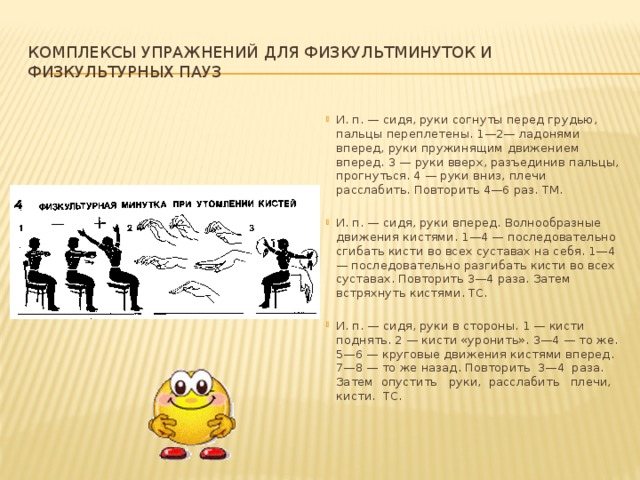
Sets of exercises for physical education minutes and physical education breaks
- I. p. - sitting, arms bent in front of the chest, fingers intertwined. 1-2—palms forward, hands springing forward. 3 - arms up, fingers apart, bend over. 4 - arms down, shoulders relaxed. Repeat 4-6 times. TM.
- I. p. - sitting, arms forward. Wave-like movements of the brushes. 1-4 - consistently bend the hands at all joints towards yourself. 1-4 - consistently extend the hands in all joints. Repeat 3-4 times. Then shake the brushes. TS.
- I. p. - sitting, arms to the sides. 1 - raise your hands. 2 - “drop” the brushes. 3-4 - the same. 5-6 - circular movements with the hands forward. 7-8 - the same back. Repeat 3-4 times. Then lower your arms, relax your shoulders and hands. TS.

Sets of exercises for physical education minutes and physical education breaks
- I. p. - sitting, hands up. 1-4 - circular movements with relaxed hands, lowering your arms to the sides. 1-4 - the same with the reverse movement of the hands up. Repeat 3-4 times. TM.
- I. p. - sitting, hands down. 1 - with an inward movement, turn the hands outward. 2 - clench your hands into a fist. 3-4 - with an inward movement, turn your hands outward, unclenching your fists. Repeat 3-4 times. Then shake your brushes in a relaxed manner. TS.
- 3. Self-massage of the forearm and wrist joint, right hand on the thigh, palm down. Perform stroking towards the center, squeezing with the edge of the palm, kneading with the pads of 4 fingers, stroking. The same is repeated in the palm up position. In this position, the wrist joint is rubbed in a forceps manner (with the thumb and forefinger) and with the edge of the palm. 50-60 s. Then perform circular movements with your brushes. The same on the left.
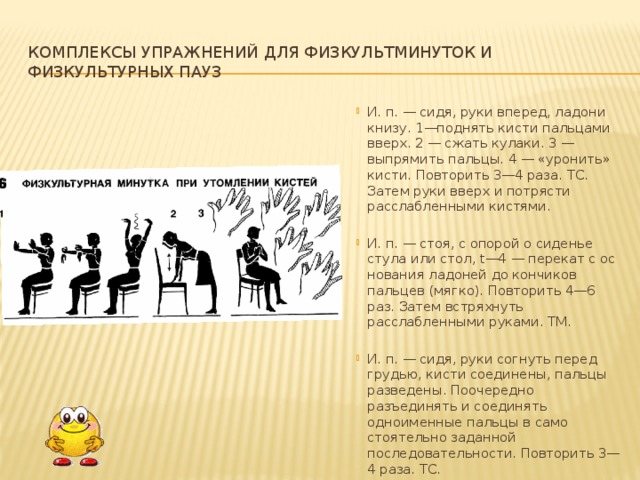
Sets of exercises for physical education minutes and physical education breaks
- I. p. - sitting, arms forward, palms down. 1—raise your hands with your fingers up. 2 - clench your fists. 3 - straighten your fingers. 4 - “drop” the brushes. Repeat 3-4 times. TS. Then arms up and shake with relaxed hands.
- I. p. - standing, with support on the seat of a chair or table, t-4 - roll from the base of the palms to the tips of the fingers (softly). Repeat 4-6 times. Then shake with relaxed hands. TM.
- I. p. - sitting, bend your arms in front of your chest, hands connected, fingers apart. Alternately separate and connect fingers of the same name in a self-defined sequence. Repeat 3-4 times. TS.
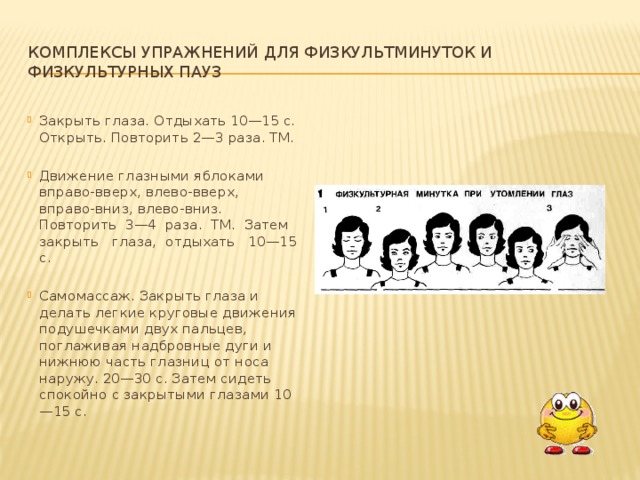
Sets of exercises for physical education minutes and physical education breaks
- Close eyes. Rest for 10-15 seconds. Open. Repeat 2-3 times. TM.
- Movement of the eyeballs to the right-up, left-up, right-down, left-down. Repeat 3-4 times. TM. Then close your eyes and rest for 10-15 seconds.
- Self-massage. Close your eyes and make light circular movements with the pads of two fingers, stroking the brow ridges and the lower part of the eye sockets from the nose outward. 20-30 s. Then sit quietly with your eyes closed for 10-15 seconds.
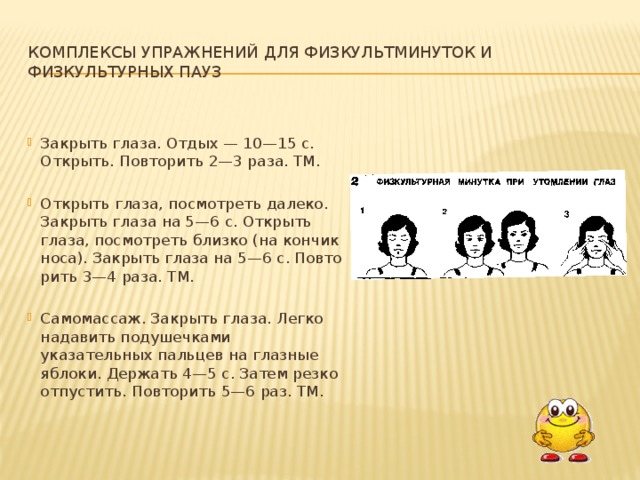
Sets of exercises for physical education minutes and physical education breaks
- Close eyes. Rest - 10-15 s. Open. Repeat 2-3 times. TM.
- Open your eyes, look far away. Close your eyes for 5-6 seconds. Open your eyes, look closely (at the tip of your nose). Close your eyes for 5-6 seconds. Repeat 3-4 times. TM.
- Self-massage. Close eyes. Lightly press the pads of your index fingers onto your eyeballs. Hold for 4-5 s. Then quickly release. Repeat 5-6 times. TM.
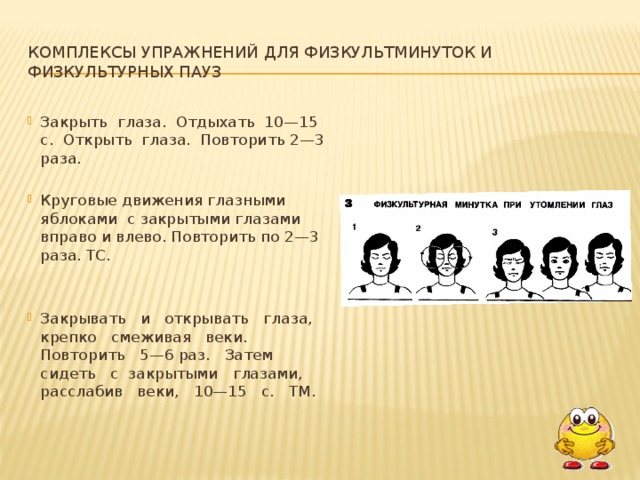
Sets of exercises for physical education minutes and physical education breaks
- Close eyes. Rest for 10-15 seconds. Open eyes. Repeat 2-3 times.
- Circular movements of the eyeballs with closed eyes to the right and left. Repeat 2-3 times. TS.
- Close and open your eyes, tightly closing your eyelids. Repeat 5-6 times. Then sit with your eyes closed, relaxing your eyelids, for 10-15 s. TM.
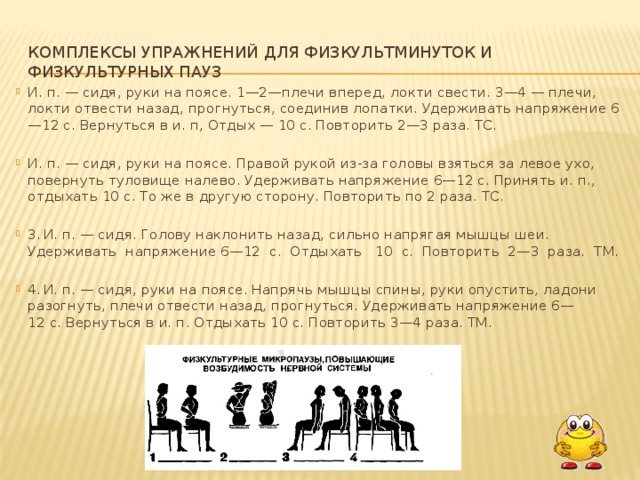
Sets of exercises for physical education minutes and physical education breaks
- I. p. - sitting, hands on the belt. 1-2—shoulders forward, elbows together. 3-4 - shoulders, elbows back, bend over, bringing your shoulder blades together. Maintain the tension for 6-12 s. Return to i. p, Rest - 10 s. Repeat 2-3 times. TS.
- I. p. - sitting, hands on the belt. With your right hand from behind your head, grab your left ear and turn your torso to the left. Maintain the tension for 6-12 s. Accept and. p., rest for 10 s. The same in the other direction. Repeat 2 times. TS.
- 3. I. p. - sitting. Tilt your head back, strongly straining your neck muscles. Maintain the tension for 6-12 s. Rest 10 s. Repeat 2-3 times. TM.
- 4. I. p. - sitting, hands on the belt. Tighten your back muscles, lower your arms, straighten your palms, pull your shoulders back, bend over. Hold the tension for 6-12 s. Return to i. n. Rest 10 s. Repeat 3-4 times. TM.

Sets of exercises for physical education minutes and physical education breaks
- I. p. - sitting, hands on the table, palms down. Press your fingers onto the table surface, holding the tension for 6-10 s. Then quickly relax your hands. Rest 10 s. Repeat 3-4 times. TS.
- I. p. - sitting, hands on the belt. Quickly tighten your gluteal muscles and the muscles of the front of your thighs. Relax your muscles. Repeat 5-6 times. TB.
- I. p. - sitting on the edge of a chair, hands on your belt, feet on your toes. Perform circular movements with your heels in and out without lifting your toes off the floor. Repeat 8-10 times. TB. Then relax your leg muscles.
- I. p. - sitting, hands on the belt. Alternately place your feet on your heels and toes, rolling forward and backward on the seat. Repeat 8-10 times. TB. Then relax your leg muscles and shake your legs one at a time.
Sets of exercises for physical education minutes and physical education breaks
Gymnastics to improve hearing
- Working to improve your vision also has a positive effect on your hearing. And, in turn, working to improve hearing has a beneficial effect on the visual organs.
- Bend the top of the ear down. We unbend, bend, as if rolling out and rolling up the ear. The ears should become warm.
- Find the dimple near the tragus. They pressed on the dimples of both ears at once - released, pressed, released.
- They pressed their fingers on the lobes, massaged them, and released them.
- We massage the entire ear in a circular motion, one way, the other. You need to massage both ears at the same time.
- We made a twig from the ring and index fingers, stuck our ears there and - up and down, up and down - so that the front and back sides of your ears were thoroughly massaged.
- We begin to pull our ears - first downwards 20 times, and then we take hold of the middle and pull upwards also 20 times.
- Grab your earlobe again and massage it thoroughly.
- Pull your ears to the side - again 20 times.
- Now we bend them forward and then in the opposite direction (20 times).
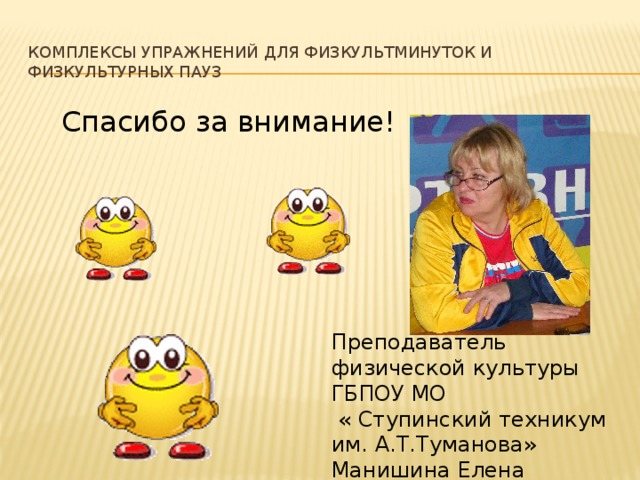
Sets of exercises for physical education minutes and physical education breaks
Thank you for your attention!
Physical education teacher at State Budgetary Educational Institution of Moscow Region
"Stupinsky Technical School named after. A.T. Tumanova" Manishina Elena Nikolaevna

